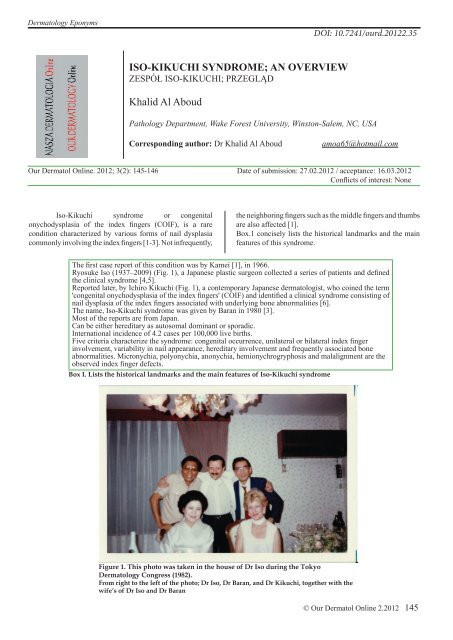download full issue - Our Dermatology Online Journal
download full issue - Our Dermatology Online Journal
download full issue - Our Dermatology Online Journal
Create successful ePaper yourself
Turn your PDF publications into a flip-book with our unique Google optimized e-Paper software.
<strong>Dermatology</strong> Eponyms<br />
DOI: 10.7241/ourd.20122.35<br />
ISO-KIKUCHI SYNDROME; AN OVERVIEW<br />
ZESPÓŁ ISO-KIKUCHI; PRZEGLĄD<br />
Khalid Al Aboud<br />
Pathology Department, Wake Forest University, Winston-Salem, NC, USA<br />
Corresponding author: Dr Khalid Al Aboud<br />
amoa65@hotmail.com<br />
<strong>Our</strong> Dermatol <strong>Online</strong>. 2012; 3(2): 145-146 Date of submission: 27.02.2012 / acceptance: 16.03.2012<br />
Conflicts of interest: None<br />
Iso-Kikuchi syndrome or congenital<br />
onychodysplasia of the index fingers (COIF), is a rare<br />
condition characterized by various forms of nail dysplasia<br />
commonly involving the index fingers [1-3]. Not infrequently,<br />
the neighboring fingers such as the middle fingers and thumbs<br />
are also affected [1].<br />
Box.1 concisely lists the historical landmarks and the main<br />
features of this syndrome.<br />
The first case report of this condition was by Kamei [1], in 1966.<br />
Ryosuke Iso (1937–2009) (Fig. 1), a Japanese plastic surgeon collected a series of patients and defined<br />
the clinical syndrome [4,5].<br />
Reported later, by Ichiro Kikuchi (Fig. 1), a contemporary Japanese dermatologist, who coined the term<br />
'congenital onychodysplasia of the index fingers' (COIF) and identified a clinical syndrome consisting of<br />
nail dysplasia of the index fingers associated with underlying bone abnormalities [6].<br />
The name, Iso-Kikuchi syndrome was given by Baran in 1980 [3].<br />
Most of the reports are from Japan.<br />
Can be either hereditary as autosomal dominant or sporadic.<br />
International incidence of 4.2 cases per 100,000 live births.<br />
Five criteria characterize the syndrome: congenital occurrence, unilateral or bilateral index finger<br />
involvement, variability in nail appearance, hereditary involvement and frequently associated bone<br />
abnormalities. Micronychia, polyonychia, anonychia, hemionychrogryphosis and malalignment are the<br />
observed index finger defects.<br />
Box I. Lists the historical landmarks and the main features of Iso-Kikuchi syndrome<br />
Figure 1. This photo was taken in the house of Dr Iso during the Tokyo<br />
<strong>Dermatology</strong> Congress (1982).<br />
From right to the left of the photo; Dr Iso, Dr Baran, and Dr Kikuchi, together with the<br />
wife’s of Dr Iso and Dr Baran<br />
© <strong>Our</strong> Dermatol <strong>Online</strong> 2.2012 145















